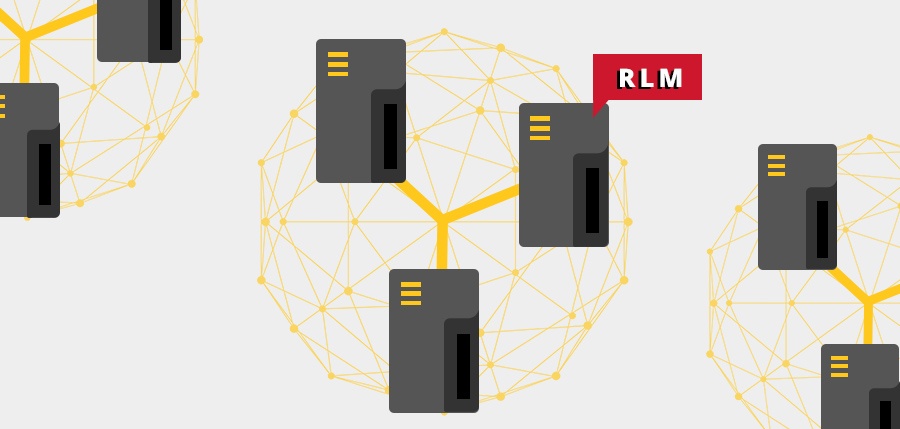Reprise License Manager (RLM) is a license management tool that offers an efficient and optimized way of controlling license usage in the organization. It provides flexibility, convenience and reliability in managing valuable and expensive software licenses both on premise or in the cloud.
RLM was created and developed by Reprise Software, a popularly known provider of one of the most reliable software license management solutions in the world.
It has a growing number of customers in 35 countries around the globe.
The mission of the company is to protect the revenue of its trusting customers by providing the most efficient way of maximizing the use of expensive software licenses in the organization.
RLM is the main product of the Reprise Software and it is continually being enhanced and developed to maintain premium services.
The Reprise License Manager structure is mostly similar with the most popular license manager in the market. It consists of three important components:
- Client library
- License servers
- License file
The client library is linked to the application of the ISV and provides access to the various license management functionalities available.
Most of the license management is done in the license servers, which is used for managing floating licenses and logging of usage data. The license servers control the denying and granting of access to the requesters of licenses.
The structure of the RLM consists of two license servers, a generic server called the rlm and an ISV-specific server called the isv.
The rlm server performs functionalities related to license management, while the isv server contains the specific license key validation and configuration related to the ISV. These two servers communicate with each other to handle license requests.
The client library and the license servers are controlled by the license file through specifying license authorization for efficient and optimized license utilization.
As part of the design protocol of RLM, the license policies are only configured and written in the license file. This is to avoid unnecessary changes to the application and the license servers, and license management confusion to the customers.
The license files are also visible and understandable by everyone.
The license file contains three types of lines:
- HOST – contains the host names of the license server (rlm)
- ISV – contains the information of the ISV license server (isv)
- LICENSE – contains the license grants from the ISV to the customer
Advantages of RLM
RLM supports various major platforms, such as Windows, Linux/Unix, and MacOS X. It supports both 32- and 64-bit architectures of these major platforms which frees its customers from the hassle of setting up machines that the organization does not have.
Furthermore, RLM comes with its own simple and intuitive application programming interface (API) that provides customers the ability to customize license management through integration.
This API can be integrated to the proprietary application of the organization and makes the license management easier and convenient.
In regards to licensing, RLM provides a convenient way of converting trial and demonstration modes into permanent licenses.
Also, a good thing with RLM is that it allows mobile licensing in which administrators can easily relocate unused licenses from a license server to another license server that needs more licenses.
In this way, licenses are optimized and efficiently utilized.
Moreover, a web interface called the RLM Web Server is also embedded with the license server. The Web Server makes license management easier with a few simple clicks on the browser and provides an overview of the license status and usages of the rlm and isv servers.
It also includes some important license management functionalities, such as reread, transfer or shutdown.
One of the most highlighted advantages of RLM is that it is transparent and open because the Reprise Software believes in an open architecture.
It provides plain text for license and report logs, all written in understandable and human readable manner, which allows the customers to more easily understand the license policies and usage of the organization.
It also gives customers the capability to perform various analysis using different analytical and reporting tools in order to visualize the true usage of licenses in the organization.
Although RLM supports plain text for the licenses, security is not an issue since RLM ensures that all the licenses are digitally signed using public key cryptography. In terms of privacy, RLM supports anonymization of usage logs to comply with privacy laws.
Enhancing RLM Functionalities
With all its functionalities, RLM still needs a powerful analytical and reporting tool to visualize the true license usage of the organization.
Open iT supports the data collection and reporting of RLM by polling license status from the RLM license utilities (rlmutil on Unix and rlmutil.exe on Windows) and parsing the report logs to create license usage reports that can be used for decision making and license inventory.
The following reports or information can be provided by Open iT reports:
- License Efficiency per Feature
- License Usage per User
- License Usage per Usergroup
- License Usage per Host
- License Denials per user
- License Denial Reasons
- Real-Time monitoring of license usages
Learn more about how to effectively manage engineering software licenses on RLM, in conjunction with other license managers. Let us guide you through your engineering software management and optimization journey.






